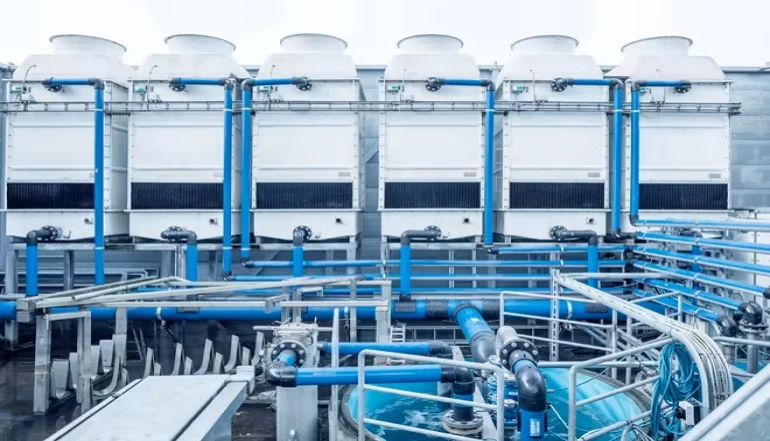Industrial Cooling Tower: Enhancing Industrial Process Efficiency through Heat Dissipation
An industrial cooling tower is a crucial piece of equipment widely used in various industries to dissipate excess heat generated during industrial processes. Its primary function is to extract heat from hot water or steam by allowing a small portion to evaporate, effectively reducing the temperature of the remaining water or process fluid. This cooled water is then recirculated to absorb more heat from the industrial process.
Key Components of an Industrial Cooling Tower:
-
Fill Media:
Fill media provides a large surface area for the water to come into contact with air. It helps maximize the heat transfer by breaking the water into smaller droplets, facilitating effective cooling through evaporation.
-
Fan and Motor:
Fans create airflow within the cooling tower, aiding in the evaporation process. They draw in the warm, moist air from the tower and expel it into the atmosphere. The motor powers the fan, ensuring efficient cooling.
-
Water Distribution System:
The water distribution system evenly distributes the hot water or process fluid over the fill media. This ensures a consistent flow for effective cooling and prevents uneven temperature distribution.
-
Drift Eliminator:
Drift eliminators capture water droplets carried by the airflow out of the cooling tower, preventing water loss and maintaining efficient water usage.
-
Basin:
The basin collects the cooled water at the bottom of the tower and directs it back to the industrial process for recirculation. It also houses the pumps that move the water throughout the system.
Importance of Industrial Cooling Towers:
-
Efficient Heat Dissipation: Industrial cooling towers play a crucial role in efficiently dissipating excess heat, maintaining optimal operating temperatures for industrial equipment and processes.
-
Energy Savings: By utilizing the natural process of evaporation to cool the water, cooling towers significantly reduce energy consumption compared to mechanical refrigeration-based cooling systems.
-
Environmental Sustainability: Cooling towers contribute to environmental sustainability by conserving water through the recirculation of cooled water and minimizing the need for fresh water intake.
-
Increased Productivity and Equipment Life: Maintaining appropriate operating temperatures with the help of cooling towers ensures the longevity and efficiency of industrial equipment, ultimately enhancing productivity.
-
Versatility and Application Range: Industrial cooling towers are adaptable to various industries, including power plants, petrochemical, manufacturing, and HVAC systems, showcasing their versatility and wide-ranging applications.
Types of Industrial Cooling Towers:
-
Natural Draft Cooling Towers:
- Use the natural draft created by the temperature difference to induce airflow.
- Ideal for large-scale applications due to their high capacity and efficiency.
-
Mechanical Draft Cooling Towers:
- Use fans or blowers to force air through the tower, enhancing heat transfer.
- Versatile and suitable for a wide range of applications and sizes.
-
Crossflow Cooling Towers:
- Inlet air moves horizontally across the downward falling water.
- Efficient and compact design, making them popular in various industries.
-
Counterflow Cooling Towers:
- Inlet air moves upward against the falling water.
- Effective for high-heat applications and generally more efficient than crossflow towers.
Industrial cooling towers are essential for maintaining efficient operations in diverse industrial processes. By effectively managing heat dissipation, these cooling systems contribute to increased productivity, equipment longevity, and overall energy efficiency, making them indispensable in various industrial settings


